State Workforce Agencies are required to communicate to claimants any information that may affect claimants’ past, present, or future benefits. Such communications can cause claimants undue stress if the information presented is confusing, written at an advanced reading grade level, or too legalistic. Providing concise, reader-focused information helps reduce burden on claimants and results in a more positive customer experience. DLT and USDOL regulatory and policy experts analyzed sample decisions sent to claimants, specifically looking at Notices of Denial, Overpayment, and Appeal, with the intent of rewriting these notices using plainer language
DLT and USDOL hoped to achieve the following by applying a plain-language lens to these notices:
- Convey the legal provisions of the decision in a way that claimants understand (and that communicates what claimants need to do next).
- Identify areas where the language can be made clearer so that claimants better understand their payment status and appeal options.
The benefits of plain language notices
Writing or rewriting your notices in plain language can yield the following benefits: Minimizing claimant confusion and stress. People applying for Unemployment Insurance are likely experiencing much more stress than normal, and it’s important to be mindful of this. To reduce stress on claimants, notices should tell claimants what they need to know, what they need to do, and how to do what needs to be done. If a claimant gets a notice that’s too complex or difficult to understand they won’t be informed and empowered to act in their best interest, thus compounding their stress.
Fewer calls about notice information. Claimants who are confused about notice content may reach out to a call center for clarification. By improving the readability and clarity of notices, State call centers can reduce the volume of such inquiry calls and focus on other challenges.
Clear guidance for claimants. The Unemployment Insurance process is complex, and states should focus on empowering claimants to make informed claim decisions, engendering trust in the system, and increasing the claimant’s confidence level.
How states can adopt plain language notices
Working collaboratively with Rhode Island, USDOL demonstrated how to structure and simplify a notice of determination as a result of a separation disqualification. The notice included a Notice of Decision,
Notice of Overpayment, and Notice of Appeal. States must review their own statutory requirements and consult with their USDOL Regional representatives to ensure that the information conveyed in the notices meets federal requirements. Here, we describe the foundational steps states can take to adopt plain language notices.
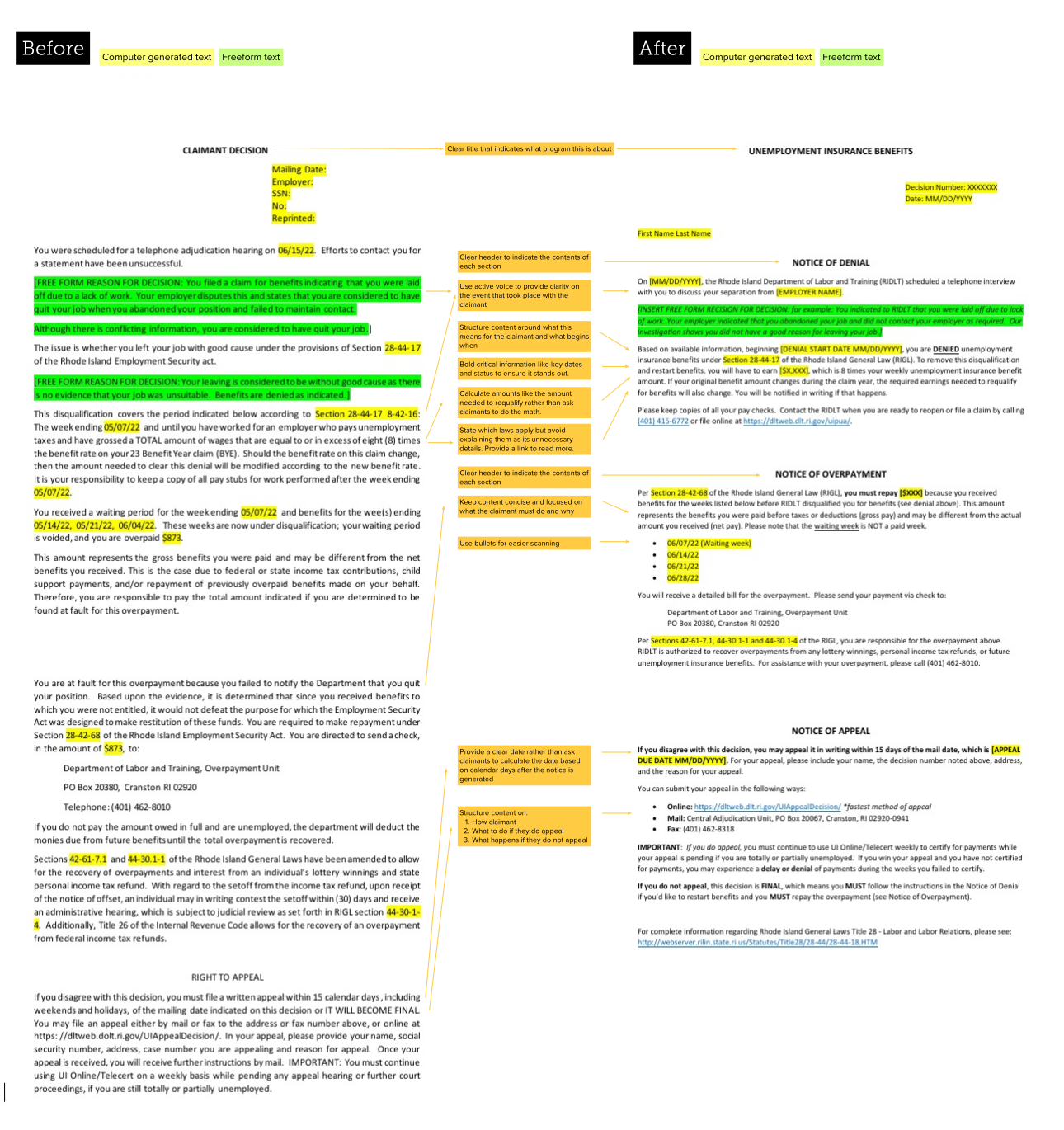
This video snippet features a research participant trying to interpret Rhode Island's notice of denial.
Step 1: Review federal and state statutory requirements. We reviewed Rhode Island’s statutory requirements to ensure we were using the correct citations We also thoroughly reviewed the notices to make sure they included sufficient information for the claimant (per federal guidelines). In this case, sufficient information included:
- A summary of the material facts that the determination is based on
- The reason for approving or denying benefits
- The conclusion of the decision
- Information about the right to appeal, or if state law requires or permits a protest or redetermination before an appeal, including time period to file, how to fil, circumstances that will extend the appeal and where to find assistance
Step 2: Review current notices through a plain language framework. After reviewing relevant statutory requirements, we reviewed Rhode Island’s existing notices through a plain-language framework. We used the following rubric to evaluate the sample notices; this rubric includes the Flesch Grade Level and Reading Ease, which are included in Microsoft Editor. PlainLanguage.gov provides additional guidelines based on the Plain Writing Act of 2010 to help agencies write content clearly. Using these resources, we were able to identify opportunity areas for the notices.
We recognize that states must cite laws, but including legal language will automatically increase the reading level of a document. We recommend linking to laws as much as possible rather than including them verbatim in notices. To help claimants more easily process important information, we recommend bolding all information that is critical for the claimant to know, including the eligibility status, overpayment due, important dates/deadlines, and next steps, to make it easier to process information.
| Category | Rating | Tips |
|---|---|---|
| Flesch Grade Level | 0-18 Grade Level | Grade 8 equates to roughly 80% of Americans being able to read your content. Grade 18 is considered an academic paper, Grade 0 is equivalent to someone learning to read. |
| Flesch Reading Ease | 0-100 Reading Ease | The higher the Reading Ease score, the easier it is for people to read. 60-70 is equivalent to a grade level of 8-9. |
| Written for the average reader | Yes, No, N/A | Target audience is 6-8th grade level. |
| Organized to serve the reader's needs | Yes, No, N/A | General content structure should be organized around what this means for claimant and their potential next steps. |
| Has useful headings | Yes, No, N/A | Headings act as landmarks that help people understand what they are about to read, so make these as clear as possible. For example, including “Unemployment Insurance Benefits” in your heading makes it clear to claimants which benefits they are about to read about, which can be helpful if individuals have applied for multiple benefits. |
| Uses “you” and other pronouns to speak to the readers | Yes, No, N/A | Addressing the reader directly and using a human-centered tone in notices can help claimants feel supported. |
| Uses short sections and short sentences | Yes, No, N/A | Overly complex sentences can be hard to parse. Review long sentences for core points and break them up into shorter sentences, grouping them by theme or timeline of events to increase clarity. |
| Uses the simplest tense possible – simple present is best | Yes, No, N/A | Speak in the present tense – simple present is best. |
| Uses base verbs, not hidden verbs | Yes, No, N/A | Use the strongest, most direct form of the verb possible. for example: “We scheduled a fact finding interview” vs “There was a fact finding interview scheduled.” |
| Omits excessive words | Yes, No, N/A | Include one main idea per sentence. |
| Uses concrete, familiar words | Yes, No, N/A | Avoid legalese, jargon, and figurative language. |
| Places words carefully | Yes, No, N/A | Avoid large gaps between the subject, the verb, and the object; put exceptions last; place modifiers correctly. |
| Uses lists and tables to simplify complex material | Yes, No, N/A | When possible, provide information in lists or tables, which are easier to process than large chunks of text. |
Step 3: Structure information in a way that makes sense to your reader. Plain language goes a long way toward helping readers understand your content, but information architecture – how your information is structured – is just as important. Here are some suggestions for how best to structure your information:
- Develop a structure with the following questions in mind:
- What does this mean for the claimant?
- Why did this happen?
- What can the claimant do next?
- Where does the claimant go if they need help, have questions, or want to request an appeal/reconsideration?
- Headings indicate what the document is about to announce, so make them as clear as possible. For example, rather than “Claimant Decision,” use something more descriptive, such as “Unemployment Insurance Benefits – Notice of Denial/Notice of Approval”
- Provide clear, succinct language on what an event or decision means for the claimant, including:
- The events that took place, including what information was gathered
- The ultimate decision and when it takes effect
- The specific section of the law applied (but not necessarily descriptions of the laws – you can link to these)
- Instructions for what to do next
- Clear due dates. Don’t ask claimants to do math; rather, provide the date by which a form or piece of information is due (e.g., “You must appeal by July 21, 2022”).
- Ways for claimants to find help or more information
Step 4: Test your content to identify opportunity areas. It’s a best practice to validate changes to claimant-facing materials by conducting research with past or present UI claimants. Doing research with actual claimants provides critical insight into how content (specifically, notifications) may perform in the real world. We tested our content after rewriting it, and our research goals were as follows:
- Uncovering what information claimants might be looking for when reading the determination notice
- Identifying critical points of confusion within the adjudication process
- Evaluating the effectiveness of the redesigned determination notice: Does the new notice address any issues/challenges claimants faced in the original notice? How so?
We worked with Rhode Island DLT to recruit 3 claimants who have varying experiences with unemployment insurance. Participant 1 was a first-time unemployment applicant who was ultimately approved; Participant 2 started receiving benefits this year and was familiar with the adjudication process; and Participant 3 was, at the time of testing, currently certifying for benefits and awaiting a decision from the appeals process.
In one scenario, we connected with a claimant who previously received some of the notices we were working to redesign; this claimant spoke to his personal experience and frame of mind while receiving these notices in the past, and what questions/issues he faced with the past notices. The claimant also reviewed the redesigned notice with Rhode Island DLT and USDOL staff, where he also addressed his impressions and interpretations of the updated content and form design.
Step 5: Collate your research into findings and use these to make concrete improvements to your notices. Interviews with claimants provide valuable insight into how people really react to and understand the notices they are sent. Below are some of our key findings from the research we conducted in collaboration with Rhode Island
Finding 1: Titles and headings provide helpful context: All participants found it clear that this letter was communicating they had been denied benefits. One participant commented how the denial status was particularly unclear on her original notice.
Finding 2: “To clear this denial” is potentially confusing phrasing: Two participants were unsure what “to clear this denial” meant. One potential point of confusion is that the alternate phrase “requalify for benefits” appears later in the same paragraph.
Finding 3: Average claimant might not understand “gross” and “net:” While two of the three participants understood the meaning of “gross” and “net,” one participant only understood the meaning because of her experience as a manager handling payroll, and stated that her employees probably wouldn’t understand what the terms meant without the definition provided on the page.
Finding 4: Statute citations are helpful, even if not completely necessary: All participants found the statute citations helpful, even if they weren’t sure if they’d ever reference them. Two of the participants mentioned they might reference the statues if they were hitting roadblocks with their appeals process.
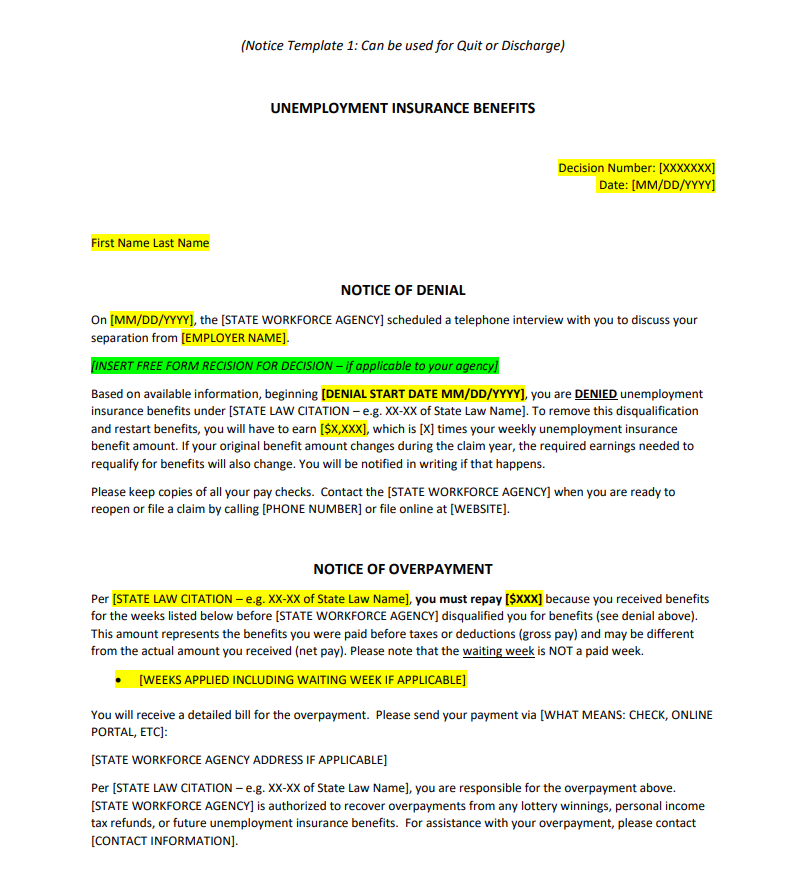
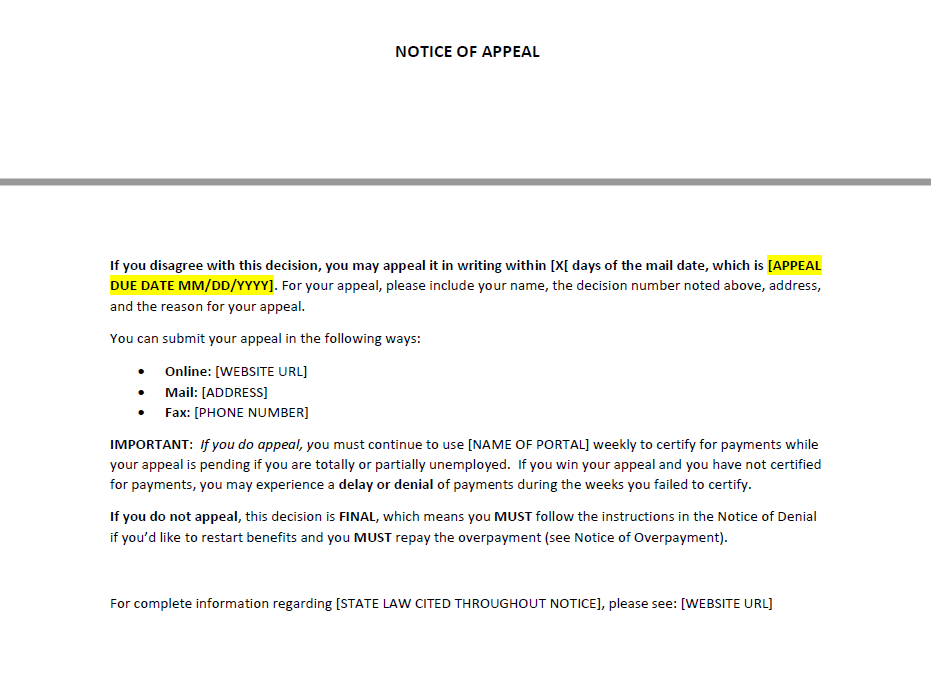
This doc features the revised notices of denial, overpayment, and appeal.
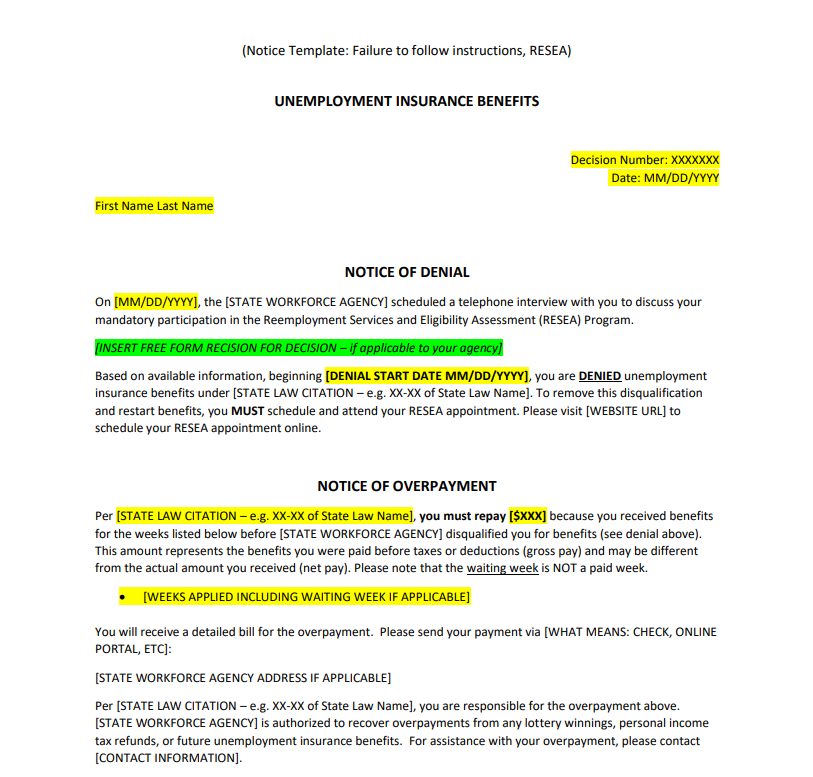
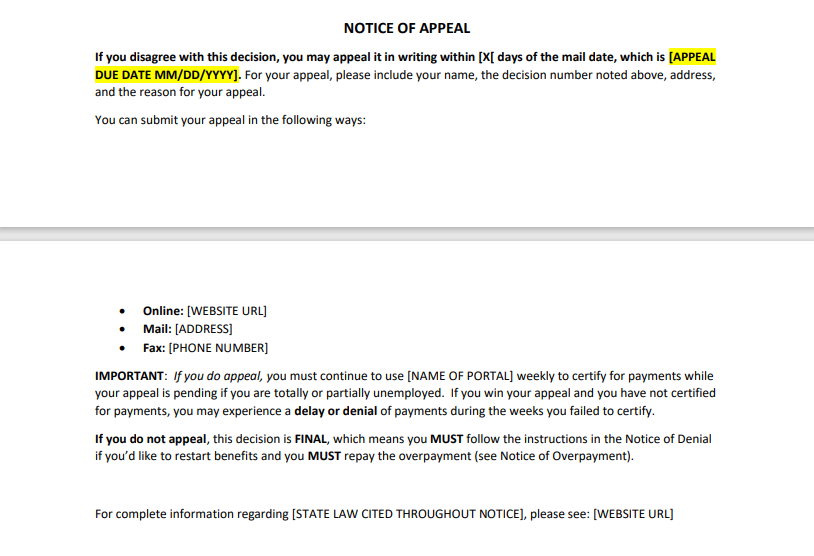
This document features a template for a revised notification for claimants who have failed to follow RESEA instructions.
